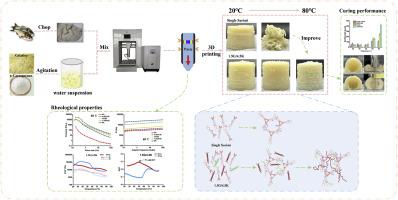A novel method for high-temperature microwave 3D printing of golden thread surimi: Combination of thermally reversible gelatin and κ-carrageenan
IF 11
1区 农林科学
Q1 CHEMISTRY, APPLIED
引用次数: 0
Abstract
Microwave 3D printing of surimi has temperature limitations and transglutaminase dependence. The current study aimed to achieve microwave 3D printing of surimi at higher temperatures (45–80 °C) with the combination of thermally reversible gelatin and κ-carrageenan to eliminate reliance on the transglutaminase and improve the molding capacity of products. Our results showed single surimi cannot be stacked when printed at 45 °C while it can be successfully extruded and molded at 80 °C after adding a combination of gelatin and κ-carrageenan to surimi paste. According to rheological data, κ-carrageenan provided the surimi paste with good elastic properties while gelatin lowered the paste's viscosity when heated. Particularly, the microwave 3D printed surimi with 4.5% κ-carrageenan and 1.5% gelatin at 80 °C exhibited relatively optimum gel strength and mechanical characteristics. The results concerning water distribution and microstructure suggested that the microwave printing process could limit the flow of water and enhance the ability of the products to retain moisture, meanwhile, the products printed at 80 °C displayed a relatively more comprehensive gel network structure. Furthermore, molecular force analysis showed hydrophobic and disulfide bond contents increased significantly with the increase of κ-carrageenan at 80 °C, suggesting the promoted protein-colloid cross-linking during microwave heating. In general, gelatin and κ-carrageenan can effectively regulate the surimi gel process during microwave 3D printing at higher temperatures, and improve the molding capacity of final products, which provide a new pattern for the future food manufacturing.

一种高温微波3D打印金线鱼米的新方法:热可逆明胶与κ-卡拉胶的复合
微波3D打印鱼糜具有温度限制和谷氨酰胺转氨酶依赖性。目前的研究旨在利用热可逆明胶和κ-角叉胶的结合,在更高温度(45-80°C)下实现对鱼糜的微波3D打印,以消除对谷氨酰胺转胺酶的依赖,提高产品的成型能力。结果表明,单个鱼糜在45℃下打印时不能堆叠,而在鱼糜膏中加入明胶和κ-卡拉胶的混合物后,在80℃下可以成功挤出和成型。流变学数据表明,κ-卡拉胶为鱼糜膏提供了良好的弹性,而明胶在加热后降低了鱼糜膏的粘度。其中,含有4.5% κ-卡拉胶和1.5%明胶的微波3D打印鱼糜在80℃下具有相对最佳的凝胶强度和力学特性。水分分布和微观结构分析结果表明,微波打印工艺可以限制水分的流动,增强产品的保湿能力,同时,在80℃下打印的产品显示出相对更全面的凝胶网络结构。此外,分子力分析表明,在80℃时,疏水键和二硫键含量随着κ-卡拉胶含量的增加而显著增加,表明微波加热促进了蛋白质-胶体交联。总的来说,明胶和κ-卡拉胶可以在高温下有效调节微波3D打印鱼糜凝胶过程,提高最终产品的成型能力,为未来的食品制造提供新的模式。
本文章由计算机程序翻译,如有差异,请以英文原文为准。
求助全文
约1分钟内获得全文
求助全文
来源期刊

Food Hydrocolloids
工程技术-食品科技
CiteScore
19.90
自引率
14.00%
发文量
871
审稿时长
37 days
期刊介绍:
Food Hydrocolloids publishes original and innovative research focused on the characterization, functional properties, and applications of hydrocolloid materials used in food products. These hydrocolloids, defined as polysaccharides and proteins of commercial importance, are added to control aspects such as texture, stability, rheology, and sensory properties. The research's primary emphasis should be on the hydrocolloids themselves, with thorough descriptions of their source, nature, and physicochemical characteristics. Manuscripts are expected to clearly outline specific aims and objectives, include a fundamental discussion of research findings at the molecular level, and address the significance of the results. Studies on hydrocolloids in complex formulations should concentrate on their overall properties and mechanisms of action, while simple formulation development studies may not be considered for publication.
The main areas of interest are:
-Chemical and physicochemical characterisation
Thermal properties including glass transitions and conformational changes-
Rheological properties including viscosity, viscoelastic properties and gelation behaviour-
The influence on organoleptic properties-
Interfacial properties including stabilisation of dispersions, emulsions and foams-
Film forming properties with application to edible films and active packaging-
Encapsulation and controlled release of active compounds-
The influence on health including their role as dietary fibre-
Manipulation of hydrocolloid structure and functionality through chemical, biochemical and physical processes-
New hydrocolloids and hydrocolloid sources of commercial potential.
The Journal also publishes Review articles that provide an overview of the latest developments in topics of specific interest to researchers in this field of activity.
 求助内容:
求助内容: 应助结果提醒方式:
应助结果提醒方式:


